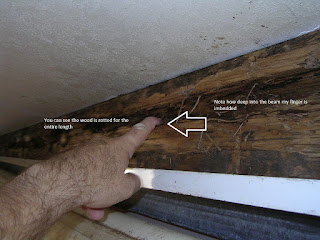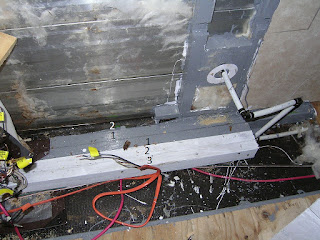There are plenty of fine Youtube movies concerning the removal and replacement of the front axles, or front bearings and hubs. My purpose here is not to make another movie to add my version of technique in removing and/or replacing these parts. I want to augment the conversation, and make suggestions that others might have left out or assumed that you already knew about this vehicle.
One of the great movies I found, showed a well trained mechanic removing and replacing (R & R ) the front right, or passenger side bearing and hub assembly. In my case I had to replace the front left, or driver's side assembly. The technique for removing the axle on the right is slightly different from the left, as there is less flex in the CV axle on the left, and the actual removal of the hub and bearing assembly was different as well. In his case he gave the hub two smacks with a hammer, I had to use the bolt technique described below.
First things first. The CV axle has to be removed, so you'll have to remove the large nut that holds that CV axle to the hub. You'll need a 35mm socket. I have air tools, so I removed the nut once the vehicles was already on jack stands, with the wheel removed.. If you are doing everything by hand, I'd recommend doing this with the wheels/tires still on the ground.
The brake caliper, pads and caliper mounting frame need to be removed. Then remove the rotor and carefully set it aside.
In my case, in order to remove the CV axle, (which has to occur before you can have access to the three bolts holding the hub to the knuckle) I had to disconnect the upper ball joint from the steering knuckle. If you have never removed a ball joint, word to the wise, make sure you completely remove the nut from the ball joint before attempting separation. If you don't remove the nut, it will be much harder to do so, once the knuckle is separated from the upper "A" frame, as the ball/shaft/stud will spin when you try to loosen the nut. You can try to hold the ball/shaft/stud with a wrench, but that will not work once the nut moves so far down the shaft.
This vehicle was heavily rusted, so a can of PB Blaster, penetrating fluid, a good wire brush, and even a thread file/restorer was needed to remove and replace fasteners. This vehicle was so rusted that the brake hose/line from the frame to the caliper broke, when the caliper accidentally fell off of the upper "A" frame. I had put it up there after removal, but didn't wire it in place.
At this point, the upper ball joint nut has been removed, and the ball joint was separated from the knuckle. (I stuck the nut back on the ball/shaft/stud, just a couple of threads, then smacked the shaft/stud on the end with a hammer. The nut was there to preserve the threads.) I also removed the lower mounting bolt for the shock and the removed the nut from the stabilizer. This allowed the lower "A" frame to swing down, offering more room for the CV axle to expand and/or slide on either spline set.
Put the large nut back on the CV axle a few threads to protect those threads, then give the shaft end a good smack with a large hammer to make sure the shaft moves in the splines. Remove the nut.
It took several techniques and positions of a pry bar to remove the CV axle from the stub shaft, on the front differential. (The other end of the CV axle.) Once that is accomplished, use a non metalic hammer (or a piece of wood placed carefully on the shaft end and a hammer) to knock the shaft end further out of the hub. You'll then be able to pull the axle out the rest of the way. Carefully lay aside the CV axle. Additionally, you'll want to inspect that for wear.
With the CV axle out of the way, you have access to the bearing hub mounting bolts.
I recommend purchasing three, 14mm X 1.5 X 90 (or longer) bolts to aid in the removal of the bearing hub assembly from the steering knuckle. Sometimes the bearing hub is easy to remove with a smack or two from a two-pound sledge hammer on either side. That technique did not work in my case, so removing the mounting bolts and replacing them with the three longer bolts allowed me to use the hammer on those bolts.
Let's look at some pictures. The picture below shows the bearing hub mounted on the steering knuckle, but without the shield, for the purpose of showing details. This shows the knuckle in the same relative position as it would be when mounted on your vehicle.
This next picture shows a crack in the upper ball joint mount of the knuckle, rendering it useless.
Just in case you need to replace the ball joints, here's what they look like off of the vehicle.
The first one is the upper ball joint, which comes on an "A" frame. This ball joint cannot be pressed out. You must remove the bolts holding the "A" frame to the brackets on the frame. This also shows a non-factory nut (14mm X 1.5) which I was using during the repair process, so I didn't ruin the original.
Here's the lower ball joint, removed from the lower "A" frame.
Once you've bolted on the new bearing/hub, you're going to install the CV axle, if it passes your inspection. I would advise using a wire brush on the splines in order to allow smooth insertion into your new bearing/hub. I would also advise some light lubricant on the splines. It should slide into the splines on the bearing/hub easily. If it does not, it means it isn't lined up correctly, so take your time.
After sliding the CV axle into the bearing/hub, you'll have to slide it onto the splines of the stub shaft (the part hanging out of the front differential) and once again, it should slide on fairly easy. You'll notice that there's a ring around the stub shaft about half way along the length. You must make sure to give the axle a good push to make it past that ring. If not, pull back slightly and give another push. There should only be about a finger thickness between the differential housing and the CV axle.
Hopefully, I have aided you in your attempt to work on your truck. Please feel free to comment.
After sliding the CV axle into the bearing/hub, you'll have to slide it onto the splines of the stub shaft (the part hanging out of the front differential) and once again, it should slide on fairly easy. You'll notice that there's a ring around the stub shaft about half way along the length. You must make sure to give the axle a good push to make it past that ring. If not, pull back slightly and give another push. There should only be about a finger thickness between the differential housing and the CV axle.
Hopefully, I have aided you in your attempt to work on your truck. Please feel free to comment.





















































